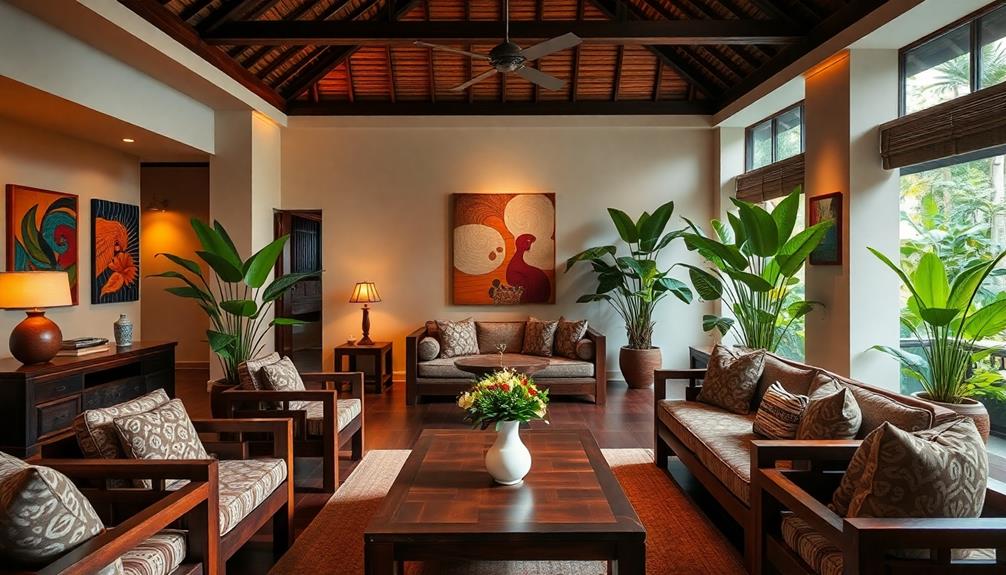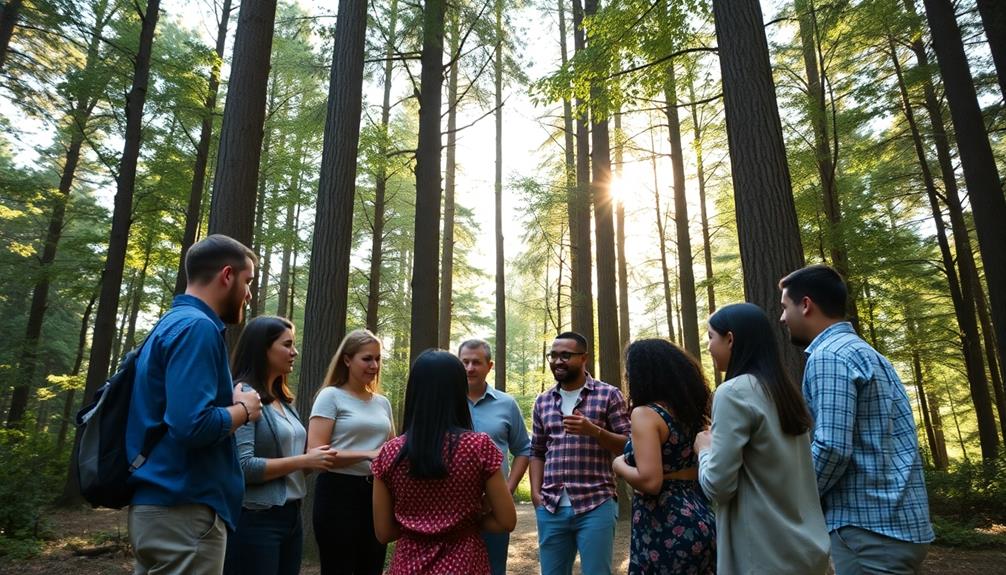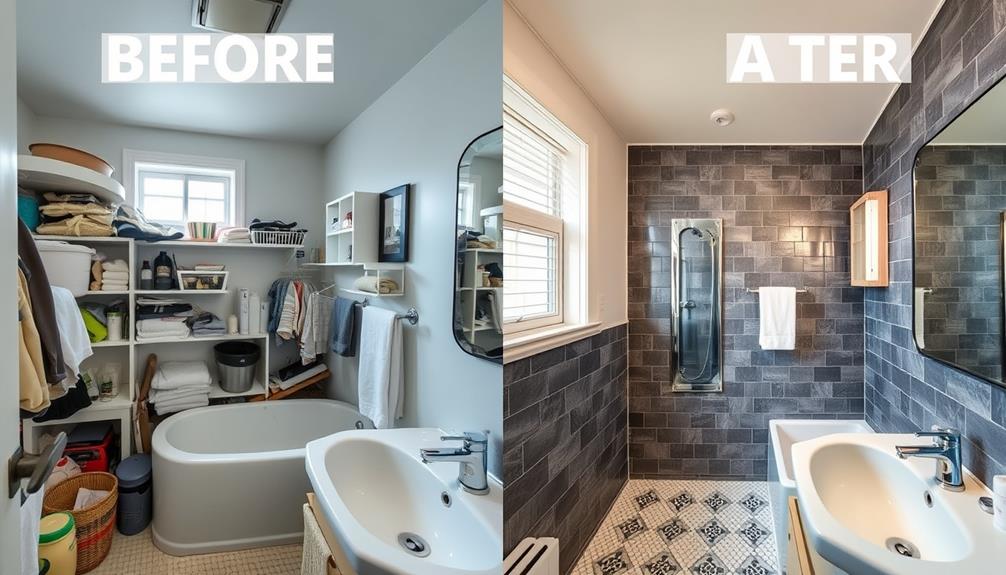To clean your couch, start by checking the care label for specific cleaning instructions based on the fabric. Then, vacuum the entire couch, including cushions and crevices, to get rid of dust and debris. If there are any stains, make sure to blot spills and use an appropriate cleaner for the fabric. If there are odors, sprinkle baking soda, let it sit, then vacuum it up. To keep your couch looking inviting and fresh, fluff the cushions and vacuum regularly to prevent dirt buildup. For more helpful tips on maintaining your couch in top condition, follow these steps. If your couch has removable cushion covers, be sure to follow the care label instructions for cleaning them. Typically, cushion covers can be machine washed or spot cleaned, depending on the fabric. Make sure the cushion covers are fully dry before putting them back on to avoid any moisture damage. Regularly cleaning sofa cushion covers will help keep your couch looking clean and well-maintained.
Key Takeaways
- Check the care label on your sofa to determine the appropriate cleaning method and fabric type.
- Regularly vacuum your sofa to prevent dirt buildup and maintain upholstery appearance and hygiene.
- Treat stains immediately by blotting spills and using fabric-specific cleaning solutions.
- Use DIY solutions like vinegar and baking soda for effective stain removal and odor control.
- Fluff and rotate cushions regularly to promote even wear and maintain the sofa's inviting look.
Check the Care Label

Before you plunge into cleaning your sofa, it's important to check the care label. This label holds essential information about the appropriate cleaning methods and materials for your specific upholstery type.
You'll often find fabric codes like "W," which means you can use water-based cleaners, or "S," indicating you should stick to solvent-based cleaners only. If the label shows "WS," you can use mild detergent with steam or dry-cleaning detergent. "X," however, means you can only vacuum the fabric.
Understanding potential side effects and interactions of cleaning products is also beneficial for ensuring a safe cleaning process, especially if you have allergies or sensitivities; common types of cold medications can provide insight into choosing the right products.
Following these care label instructions is essential to prevent damage and extend your sofa's lifespan. Ignoring this step could lead to fading, shrinking, or even ruining the upholstery.
If you can't find a care label, don't worry—try identifying the fabric type through a visual and tactile assessment to determine the best cleaning approach.
Incorporating regular cleaning and adhering to the care label can help maintain your sofa's appearance and hygiene over time.
Vacuum the Sofa
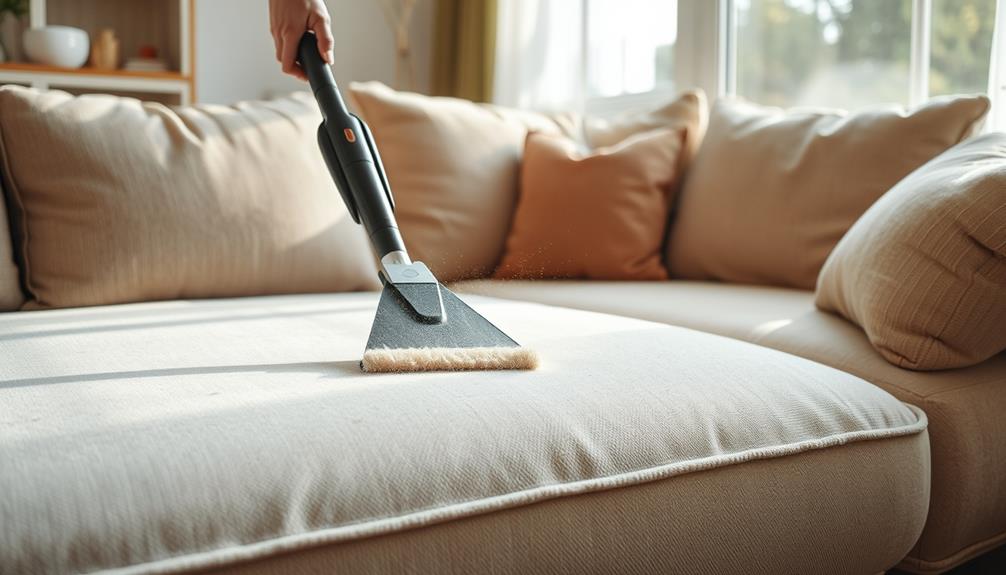
After checking the care label, it's time to tackle the next step: vacuuming your sofa. Regular vacuuming every 1 to 2 weeks is essential to prevent dirt buildup and extend the life of your upholstery. To effectively reach crevices where pet hair, crumbs, and dust accumulate, use a hand vacuum or a brush attachment. Don't forget to vacuum both sides of loose cushions and under them to eliminate hidden allergens.
Incorporate vacuuming into your routine maintenance for enhanced appearance and hygiene. For best results, consider using a lint brush or fabric shaver alongside vacuuming to remove any pilling or surface lint. Below is a simple guide to help you stay on track:
| Cleaning Tips | Action |
|---|---|
| Vacuuming Frequency | Every 1-2 weeks |
| Areas to Focus | Crevices, under cushions |
| Tools Needed | Hand vacuum, brush attachment |
| Additional Tools | Lint brush, fabric shaver |
Identify Fabric Type
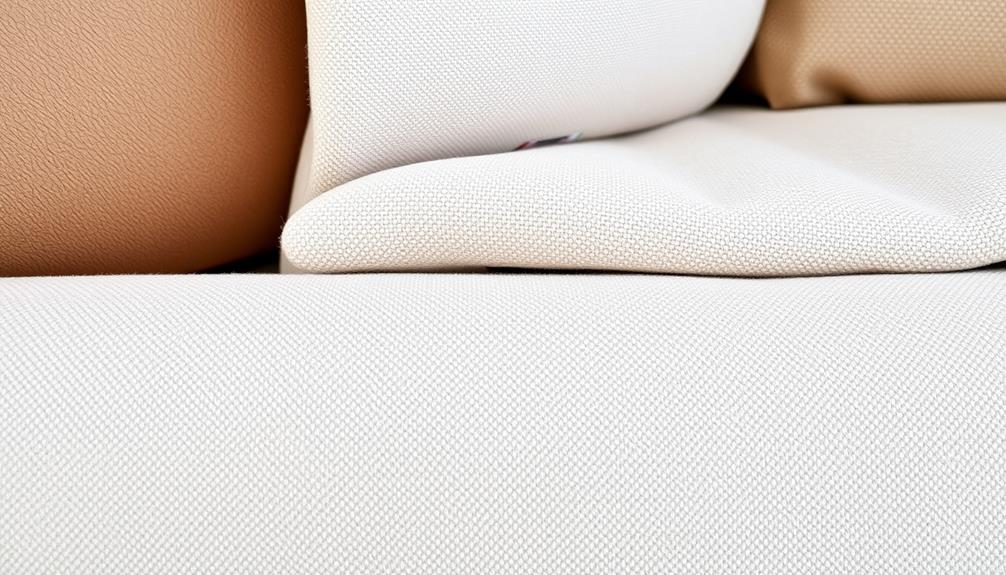
Identifying the fabric type of your sofa is vital for effective cleaning and maintenance. Start by checking the cleaning tag, usually found on the underside or back of the sofa. This tag includes a code that indicates the appropriate cleaning techniques—W for water, S for solvent, WS for both, or X for vacuum only.
Common upholstery fabrics include cotton, polyester, microfiber, leather, and velvet, each requiring specific care. Understanding your fabric type is essential to avoid damage during cleaning, as each fabric has unique characteristics that influence the best cleaning approach.
For instance, using water on suede can lead to permanent water stains, while leather needs special conditioners post-cleaning to maintain its texture and sheen. If you can't find a cleaning tag, don't worry; you can consult online resources or fabric identification guides for help, similar to how exploring personal design styles can reveal valuable insights.
Regularly identifying and understanding the fabric type of your sofa can enhance its longevity and appearance. By applying the correct cleaning methods tailored to your upholstery fabrics, you can guarantee your sofa remains in great condition for years to come.
Clean and Treat Stains
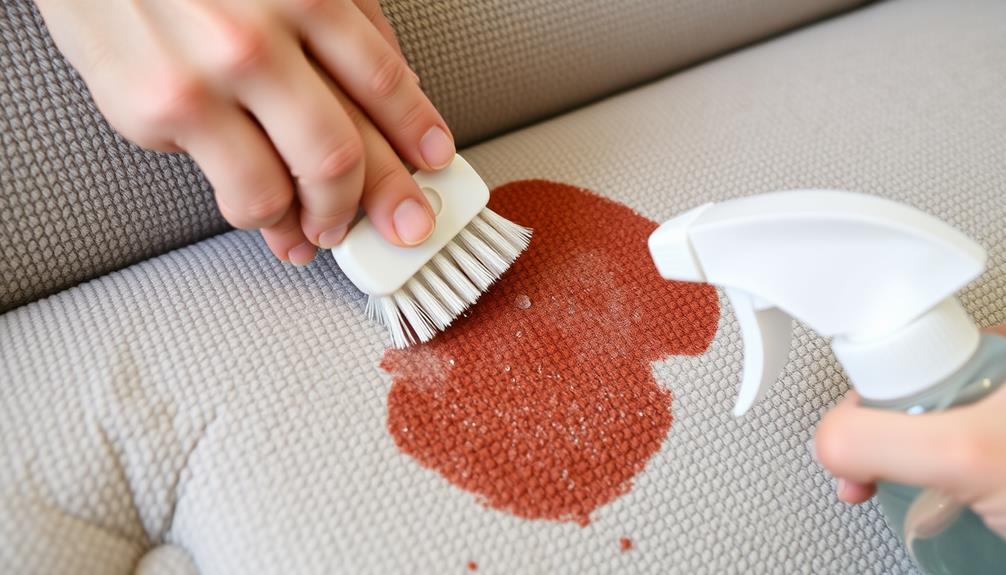
When it comes to stains, acting fast is key. You'll want to blot spills right away to stop them from setting, and the cleaning method you choose should match your sofa's fabric type.
For instance, regular cleaning can prevent tougher stains from forming, much like how fuel injection cleaning enhances vehicle performance.
With a few DIY solutions, you can tackle stains effectively and keep your sofa looking fresh.
Immediate Spill Response
Spills can be a nightmare, but swift action can save your sofa from stains. The key is immediate response. As soon as you notice a spill, grab an absorbent cloth and gently blot the area. Avoid rubbing, as it can spread the stain and set it deeper into the fabric.
For water-based stains like juice or coffee, mix vinegar, water, and a few drops of dish soap. You might also consider using essential oils for their natural cleaning properties; for example, essential oils for cleaning can help eliminate odors and freshen up your sofa. Apply this cleaning solution gently with a cloth to treat the area.
For oil-based spills, sprinkle baking soda on the affected spot to absorb the oil. Let it sit for about 15 minutes before vacuuming it up.
Always remember to perform a spot test with any cleaning solution on a hidden part of the fabric first to verify it won't cause discoloration or damage.
After treating the stain, allow the area to air dry completely. This step is vital to prevent mildew growth and maintain your sofa's fabric integrity.
Fabric-Specific Cleaning Techniques
Cleaning a sofa can feel overwhelming, but knowing the right techniques for different fabrics makes it manageable.
For cloth couches, start by using a soft brush to loosen debris. Then, mix baking soda with a DIY cleaner made from dish soap, vinegar, and water. This method is time-efficient and effective for lifting stains. Gently dab at tough stains and let it dry.
If you have a microfiber couch, spray rubbing alcohol on the stained area, scrub gently, and fluff the fabric with a dry brush to restore its texture.
When dealing with suede upholstery, avoid water to clean. Instead, use a soft brush and a specialized suede cleaner, blotting any stains and allowing the fabric to dry naturally.
Velvet couches require a different approach; absorb moisture with paper towels, lift solid stains with a butter knife, and blot with a detergent solution. Steam cleaning can help remove wrinkles and maintain the appearance.
For couch cushions, start by removing pet hair with rubber gloves and vacuum thoroughly. Then, select an appropriate solvent-based cleaner for your fabric, testing it on a small area before applying it fully.
Following these fabric-specific techniques makes cleaning easier and keeps your upholstered furniture looking great.
DIY Stain Removal Solutions
Tackling stains on your sofa doesn't have to be an intimidating task. With a few DIY stain removal solutions, you can effectively clean a couch and restore its appearance.
For fabric sofas, mix one cup of vinegar, one cup of water, and two tablespoons of dish soap. Apply this DIY stain remover gently with a clean cloth, blotting the affected area until the stain lifts. Regular cleaning of your upholstery is crucial to prevent odor and maintain its appearance, similar to the importance of routine health checks for pets routine health checks for pets.
If you're dealing with greasy stains, sprinkle baking soda on the affected area to absorb the oil. Let it sit for 15 minutes, then vacuum it up before using a water-based cleaner.
For ink stains on microfiber, dab rubbing alcohol onto a cotton ball and gently press it on the stain, allowing it to air dry for the best results.
For pet stains and odors, combine equal parts vinegar and water in a spray bottle, apply it to the area, and blot with a clean cloth. Finish by sprinkling baking soda to neutralize any lingering odors before vacuuming.
Remember to always conduct a spot test in an inconspicuous area first to verify your solutions won't damage the fabric. These tips will help you effectively remove stains from your sofa!
Remove Odors Effectively
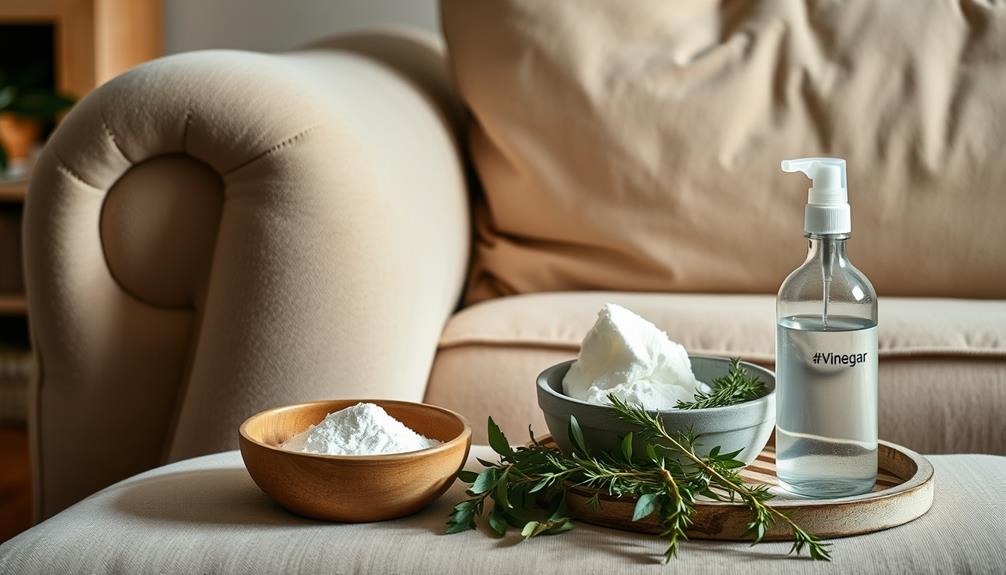
To keep your sofa smelling fresh, it's vital to address odors promptly and effectively. Start by identifying the fabric type, as different materials may require specific cleaning solutions to avoid damage.
A quick and easy method to neutralize odors is to sprinkle baking soda generously on the cushions. Let it sit for at least 15 minutes before vacuuming to remove any remaining odors and clean dust. If you have pets, be mindful that certain cookie usage considerations may apply when choosing cleaning products, as some may not be safe for them.
For more serious odors, mix equal parts of distilled vinegar and clean water in a spray bottle. Lightly mist the affected areas and let it sit before allowing the sofa to air dry; this works best for eliminating lingering smells.
If you have pets, consider using enzymatic neutralizers designed specifically for pet odors, following the package instructions for best results.
These home-made solutions can make a significant difference in keeping your sofa looking and smelling fresh. Remember that regular maintenance, including immediate spot cleaning of spills and vacuuming, is fundamental in preventing the buildup of odors.
Regular Maintenance Tips
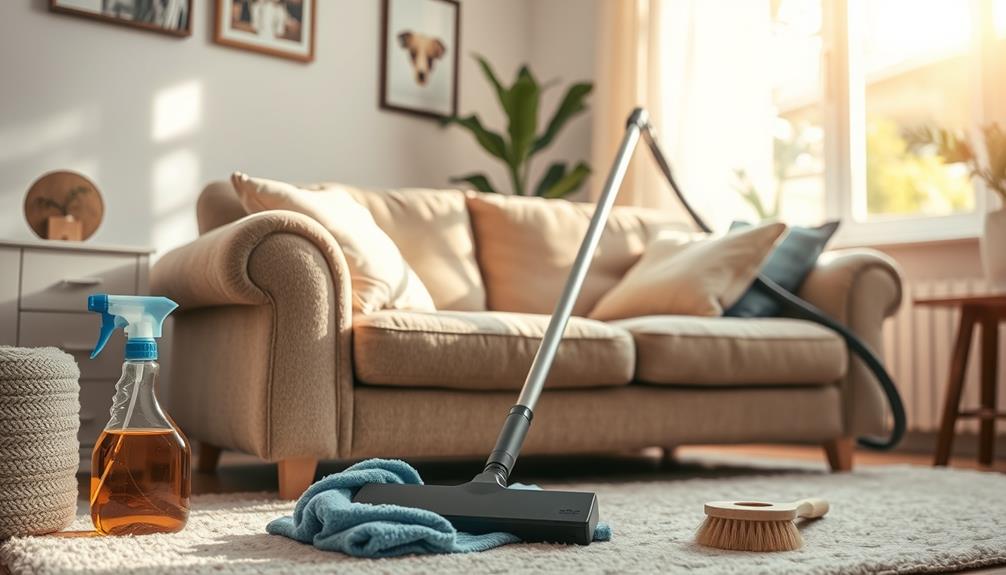
To keep your sofa looking its best, regular maintenance is key.
Vacuuming every few weeks helps eliminate dust and pet hair, guaranteeing your upholstery stays clean and fresh.
Consider using a vacuum with superior dust and allergen elimination for ideal results, while fluffing and rotating cushions ensures even wear.
These simple steps can greatly extend the life of your upholstery and maintain its appeal.
Routine Vacuuming Techniques
How often do you think about vacuuming your sofa? You should aim for regular vacuuming at least once a week to prevent dirt buildup and extend your sofa's fabric life.
Start by using a hand vacuum or a brush attachment to effectively remove surface debris. Focus on those crevices where pet hair and food crumbs tend to hide. Regular cleaning not only enhances the appearance of your sofa but also contributes to better indoor air quality, similar to how air purifiers need maintenance for peak performance.
Don't forget to vacuum both sides of your loose cushions. Lifting them allows you to access hidden debris underneath, which can accumulate over time.
Incorporating a lint brush into your routine can be a game-changer for quick hair and dust removal on fabric surfaces. This guarantees your sofa remains clean and fresh, enhancing its overall appearance.
Regular vacuuming not only improves the look of your sofa but also contributes to better indoor air quality. By reducing allergens and pollutants, you create a healthier living environment.
Cushion Fluffing Strategies
Maintaining your sofa's appearance goes beyond regular vacuuming; it also involves keeping those cushions in top shape.
Regular fluffing of your couch cushions is essential for restoring their shape, preventing a lumpy look, and ensuring consistent comfort. Additionally, just like how the presence of security systems deters criminals from targeting your home, keeping your cushions fluffed can deter wear and tear, making your sofa look more inviting.
Here are some strategies to help you maintain your cushions effectively:
- Fluff After Cleaning: Always fluff your cushions after vacuuming to maximize dust removal and rejuvenate the fabric.
- Rotate Cushions: Periodically rotate your cushions to distribute wear and tear evenly, extending their lifespan.
- Shake It Out: For removable cushions, shake them out every few weeks to prevent fillings from settling unevenly.
- Use the Right Technique: Grab opposite corners of the cushion and pull them apart gently while compressing and releasing to enhance their fluffiness.
- Establish a Routine: Incorporate fluffing into your regular maintenance schedule to keep your sofa looking inviting and fresh.
Frequently Asked Questions
What Is the Best Way to Clean a Fabric Sofa?
To clean your fabric sofa, start by identifying the fabric type. Regularly vacuum it, blot stains immediately, and use a suitable DIY cleaner. For deeper cleaning, consider steam cleaning and guarantee it air dries properly.
Can I Wash My Couch in the Washing Machine?
Imagine trying to fit a giraffe in a compact car—it just won't work! Similarly, you can't wash your couch in a machine. Always check care tags; some fabrics need special cleaning methods instead.
How to Deep Clean a Sofa?
To deep clean your sofa, vacuum thoroughly, use an upholstery cleaner for stubborn stains, and check the fabric care tag for specific instructions. Always spot test solutions to avoid damaging your sofa's material.
Can We Wash Sofa at Home?
Did you know that 80% of household dust accumulates in upholstery? You can wash your sofa at home, but it depends on the fabric type. Always check the care tag before proceeding with any cleaning method.
Conclusion
Now that you've tackled the task of washing your sofa, it's like giving it a new lease on life. With a little care and regular maintenance, your couch will shine like a diamond in the sun, inviting you to sink into its comfort. Remember, a clean sofa isn't just about looks; it's about creating a cozy haven in your home. So, roll up your sleeves and keep that fabric looking fabulous for years to come!

